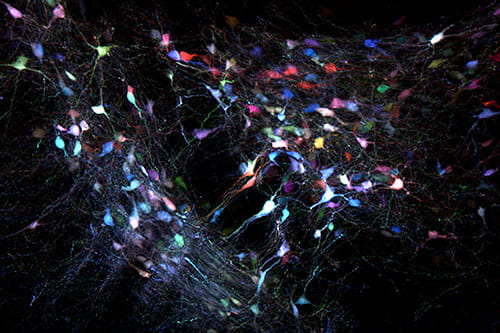Robinson Lab Research
The Robinson Lab studies how brain circuits involved in motivation, reward and attentional control are dysregulated in mouse models of neurodevelopmental disorders. We focus on neurofibromatosis type 1 (NF1), an autosomal dominant disorder that affects about one in 3,000 individuals due to mutations in the NF1 gene, whose protein product neurofibromin is a negative regulator of Ras-MAPK signaling.
Our research employs advanced molecular and imaging techniques, including genetically encoded calcium and neurotransmitter sensors, optogenetics, tissue clearing, and novel systemic adeno-associated viral vectors (AAV) that freely cross the blood-brain barrier. This approach allows us to probe the structure, function, and connectivity of genetically defined cell types in the brain that may contribute to cognitive symptoms in NF1 and other rasopathies. Additionally, we are utilizing systemic AAV vectors in the development of new gene therapies that we hope will eventually lead to improved treatment of pediatric diseases of the central nervous system.

Multi-color dopaminergic neurons labeled with the systemic AAV-based method Th-VAST.
Current Projects
Understanding Dopaminergic Dysfunction in NF1
The neurocognitive symptoms of neurofibromatosis type 1 (NF1) include impaired executive function, attention and spatial learning. Previous research suggests that these phenotypes could be due to defective development of dopaminergic projection neurons, which help translate relevant internal and external stimuli into motivated behavior. The Robinson Lab uses diverse molecular and imaging techniques to study these circuits in the context of Nf1 haploinsufficiency in mouse models. This includes the use of the genetically encoded dopamine sensor dLight1 to optically monitor dopamine release dynamics in awake, behaving mice; patch clamp electrophysiology; optogenetics; and viral vector-based methods for circuit mapping and morphological reconstruction. It is our hope that by uncovering circuit-level perturbations underpinning cognitive symptoms, we can lay the foundation for the development of more targeted therapies for NF1.
Development of Systemic AAV Gene Therapies
Recently, systemic adeno-associated viral (AAV) vectors, such as AAV-PHP.eB, have been developed that freely cross the blood-brain barrier to provide efficient brain-wide transgene expression after intravenous administration. This was not possible with existing AAV serotypes, such as AAV9. These new systemic AAV capsids have opened new avenues for gene therapy, genome editing, intact circuit analysis, and tool development. Our lab utilizes these viral vectors in diverse applications, including the development of gene therapies for disorders of the central nervous system. Current efforts in the Robinson Lab focus on modulating Ras-MAPK signaling pathways, which are upregulated in NF1 and other rasopathy syndromes, although we are interested in designing interventions across a broad range of pediatric neurological disorders.




